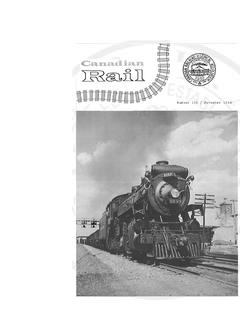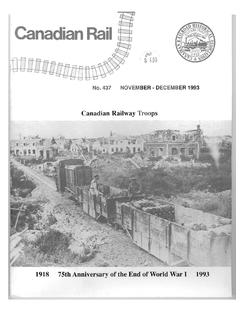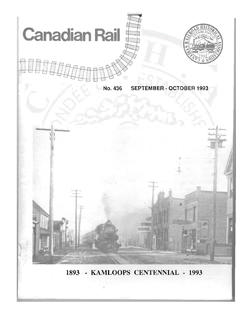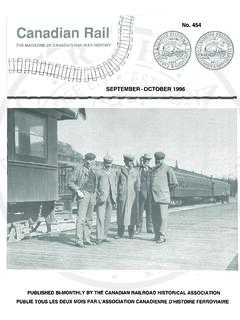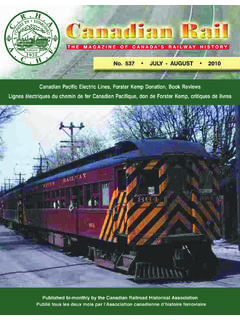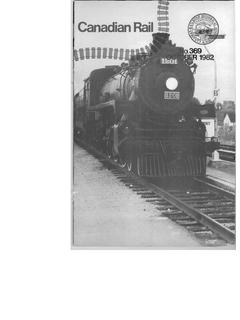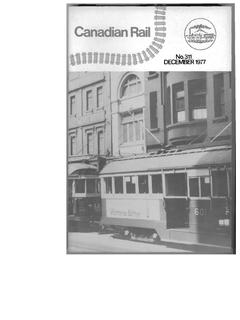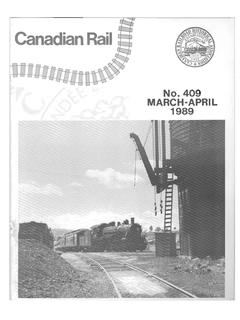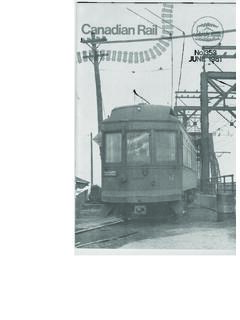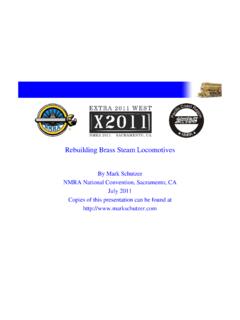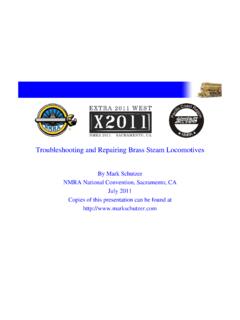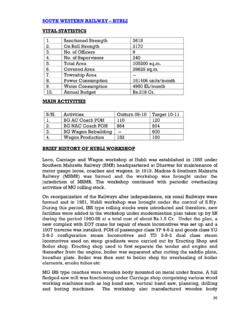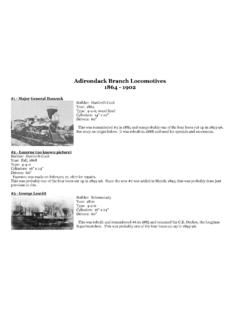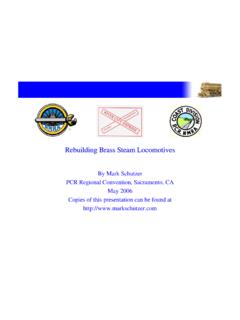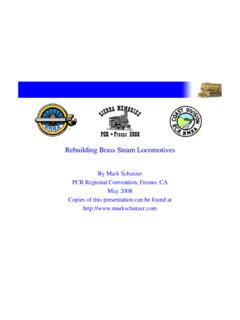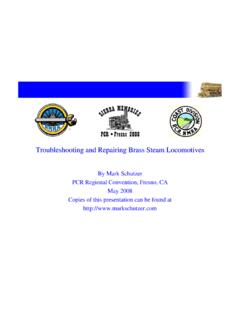Transcription of Canadian Rail no303 1977 - Exporail
1 Canadian rail a APRIL 1977 An"""us Sho gQ . THE CANA"" PACIfIC RAILWAY Ps All photographs courtesy CP photographic services and we appreciate the kind co-operation of Mr. Frank Stelfox The sprawling collection of buildings running parallel to Rachel Street in east-central Montreal has long been known simply as "Angus Shops". Built in 1904 and named for Richard 8. Angus, then General Manager of the Bank of Montreal and a Uirector of the Canadian Pacific Railway Company from its inception in 1881 until his death in 1922, till! new shops ~Iere necessary in order to replace the CPR's Delorimie~ Shops, which could not expand due to their confined location near tile harbour front north of Notre-Dame Street and east of Delorimier Avenue. This original location was a plot of land 4800 by 2100 feet. The new Angus Shops comprised some 37 acres with a total trackage of approximately 50 miles.
2 There was an extensive gen-eral repair shop. intended to perform work for the entire railway system. Most of the locomotive repair work was soon transferred from the Delorimier Shops and the car-building facilities were moved from Hochelaga Shops. After Angus Shops were opened in 1904, the construction of the first steam locomotive was completed under the direction of Vaughan, Superintendent of Motive Power. This was an 0-6-0 switcher, Number 2045, Angus Shops BIN 1385, which came off the erecting floor in November of that year. This switcher was followed by some 677 other engines, the last of which was G-5-a class 4-6-2 Number 1201, BIN 2074, built in June, 1944. ~IWhat better subject to grace the cover of our April issue than this ~1951 photograph depicting a skillful patternmaker at work in CPR's Angus Shops. This craftsman is representative of the thousands of 'non operating' railway employees who we normally don't get to see preforming their particular trade but are so vital to the efficient operation of a railroad.
3 +A partial aerial view of Angus shops taken in 1948 before total ur-banization surrounded the giant plant. I V Interior view of the wood freight car shop in the days when wooden cars were the rule rather than the exception. One has to be im-} pressed with the overall neatness of the shop, no doubt to reduce the obvious fire hazard in such a location. From wood to steel, here we see the interior of the steel car shop. Unfortunately the date of the photo is unknown but plainly visible is a variety of rolling stock including: box, gondola, passenger and baggage cars in for repairs of varying degrees. Canadian 101 R A I L Angus Shops was a city in its~lf. It had a power sta-tion, a hopital, ambulance service, a lieating plant, a police force, a fire brigade, lunch rooms, a shop-canteen service, a recreation centre and a total population of about 7,500 employ~es at the height of its activity.
4 There were, at one time, some 68 buildings: 31 main buildings, such as locomotive erecting shops, and 37 auxiliary shops, such as machine shops and carpenters' shops. There were facilities for building locomotives and cars as well as those for at least 90% of the necessary maintenance and heavy repairs on this equipment. At the peak of activity, five new steam locomotives were constructed each month, in addition to 10 new passenger cars and 40 new freight cars and including repairs of all kinds to existing equipment. The repair shops at Angus had a capacity of 100 shop repairs per day on both wooden and steel cars, which figure was developed to about 21,000 repairs a year. Included were repairs of all types: conversions, modernizations, improvements to bra-kes, lighting, springing and trucks and wheels. After the advent of the automobile, car carriers were adapted to the changing styles.
5 Railway passenger cars were modernized with steel-sheath-ing and air-conditioning. To carry out these repairs, there was a locomotive re-pair shop, four passenger car and two freiglit car repair build-ings, a wheel-casting foundry, a general castings foundry, a track frog and switch repair shop, a nut-and-bolt manufacturing shop, a large blacksmith shop, a truck repair shop, a car metal-working machine shop, one of the largest planeiny mills in Canada, electrical shops, a cabinet and varnishing shop for in-terior accessories, pattern, brass and tinsmithing shops and, of course, administration offices. All of these varied and com-prehensive facilities were necessary to perform the building and maintenance associated witil sucil a huge railway operation. The wheel foundry could turn out more than 90,000 locomotive and car wheels annually.
6 Tile grey iron foundry re-quired more than 15,000,000 pounds of iron each year. Angus Shops needed for a year's operation 16,800,000 board-feet of lumber, 40,000 pounds of steel, 18 million kilowatt-hours of electricity, million cubic feet of gas and million cubic feet of water. Angus Shops always had the reputation for being able to do the impossible and World War II established this reputation beyong a doubt. At tile outset of the war, the Canadian Pacific Railway Company placed the facilities of Angus Shops at the dis-pOSition of the Government of Canada. In June 1940, the first order for tanks was placed and Anyus would make more than 1,700 of these steel monsters before the war's end. This production was an added burden to Angus Shops, whose employees were all hard at work keeping the railway operating. Added to tile order for tanks was an order for marine engines, to power frigates and corvette-type destroyers.
7 Range-finders for naval guns were required; "Asdic" submarine detection devices were needed; Angus Shops made them, along with a multitude of machine-tools. In between times, the employees of Angus Shops establ ished new The wheel shop cl rca 1946, no facet of the ra i 1 ~Iay opera ti on was lacking at Angus Shops. No less than 74,000 cast steel wheels were turned out per year in the peak years of Angus. records for blood donations, essential to save the lives of many wounded Canadian soldiers, sailors and airmen. The repair programmes accomplished at Angus Shops in this critical period were vital to the railway. Testing and inspection departments, monitoring every piece of equipment on the railway, confirmed that annual repairs and rebuilding were held to a minimum by good workmanship and a sense of personal responsibility on the part of every employee at Angus Shops.
8 One of the most interesting operations at Angus Shops Canadian 103 R A I L was the complete reconditioning or Class 1 repair of a steam locomotive . The necessity of such a complete overhaul generally depended on many factors including the condition of the boiler, firebox, grate, valve gear and motion, as well as mileage run since the last overhaul and any particular requirements neces-sitated by the terrain through which the locomotive operated. On arrival at Angus, the engine was taken to the coal-i n g pit w her e the rem a i n i n g co ali nth e ten d e r \~ a s r e r,lO v e d TIl e firebox grates were then cleaned, the ashes were dumped, the water drained from the boiler and the tender and the firebrick arch was taken down and removed from the front end of the firebox. The dead engine was then moved to the sand-blast house, where pitted and rough exterior painted surfaces were first thoroughly cleaned and then covered with a primer coat of rust-retardant red oxide paint.
9 From there, the engine was taken into the erecting shop and placed on the stripping track, while the tender was separated from the engine and taken to the Tender Shop. To lift a multi-ton engine off its wheels was indeed a major task requiring the removal of all guard stays, brake gear, main and side-rods and, at this point, various other crafts joined tJLe project to perform their tasks. The smoke-box front, grates , headlight, handrails, dynamo, steam and safety valve casings and the automatic fire-door were all removed by the Erecting Shop crew; the firebox and cylinder jackets by the Jacket Shop; the smoke-box netting and plates from the front end were taken off by the Tank Shop gang, which also commenced to strip the ash pan. The Carpenter Shop crew removed firebox lagging, so that the firebox could be exa-mined properly when being tested and the cab-seats, window sashes and arm-rests were removed.
10 After tile Steamfitter Shop gang had stripped the pipes for testing, the boiler and frame were lifted off the wheels by two cranes which trundled it down the shop and placed it upon the pit where the repairs were to be made. Assuming that the repair of the locomotive \~as to be done on an lS-day schedule. tile progress of the principal work was as follows: 2 3 4 5 6 Operation stripping; stripping; hydrostatic test of boiler; stripping complete d and all parts cleaned and delivered; boiler tube removal com-menced; boiler tube removal completed; driving-box brasses and wearing faces removed; valves and valve motion cleaned and tested; main and side-rods tested; old cylinder and valve bushings removed; boiler scaled and smokebox cleaned; new driving -box brasses in place; superheater header examined; frames repaireu; cylinders repaired; driving boxes drilled; ',,-c Proof positive that steam locomotives were built at Angus as we witness here the milling of a pair of main rods in 1948.

